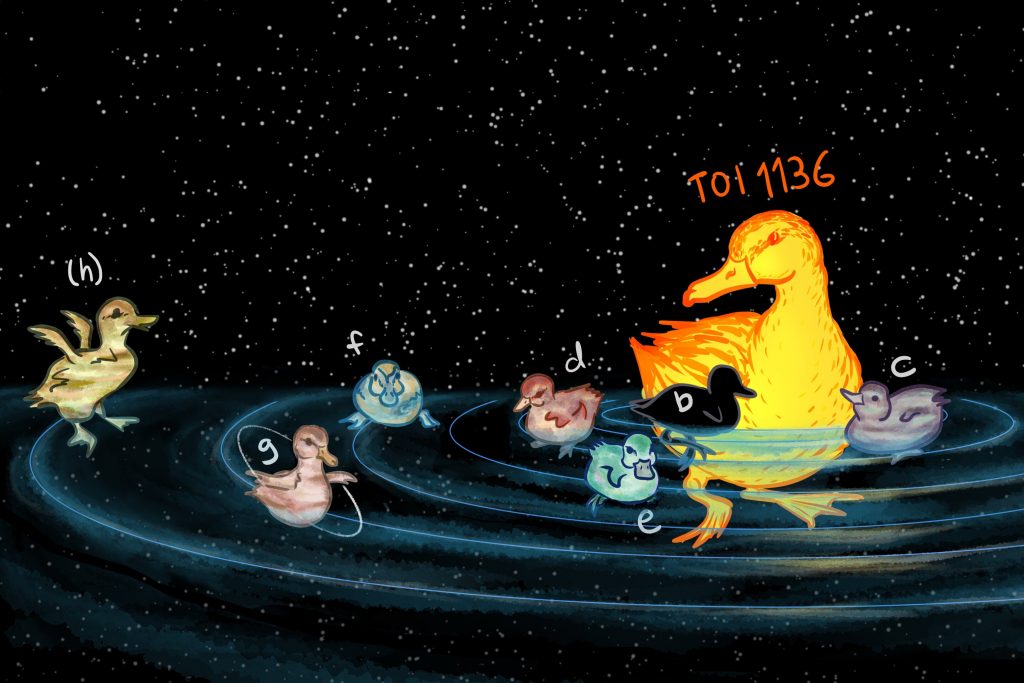A recently discovered planetary system, which includes six confirmed exoplanets and one suspected, provides valuable information about planetary formation and evolution. Led by astronomers from the University of California, a research group that includes telescopes and instruments located in different parts of the world has made more precise measurements of exoplanetary masses, orbital data and atmospheric properties than before.

Published in the Astronomical Journal In their studies Researchers report the results of their research using the TESS space telescope and the Keck Observatory. The article provides a comprehensive description of exoplanets orbiting TOI-1136, a dwarf star more than 270 light-years from Earth. The star's environment in the Milky Way was already studied in 2019 based on data from the TESS space telescope. It then became possible to estimate the mass of the system's planets for the first time by observing the transit time variation (TTV). The essence of this method is to track the small changes that occur at the precise times of planets crossing in front of the star as a result of the collective attraction of other nearby planets.
In their latest research, the astronomers examined data on changes in transit time as well as analyzing the star's radial velocity. With the help of the Lick Observatory's APF (Automated Planet Finder) instrument and the WM Keck Observatory's high-resolution echo spectrometer, they were able to detect subtle changes in the star's motion through the red-blue shift of the Doppler effect, through which subtle changes in the star's motion were detected. Planetary masses can be calculated with unprecedented accuracy.
The researchers created computer models based on data from hundreds of radial velocity measurements and transit time changes, thus obtaining accurate information about the planets. The lead author of their study, Corey Baird (UCI), said that by combining two different types of data sets, they gained more knowledge about the system than ever before. “It took a lot of trial and error, but after developing the most complex planetary system model in the exoplanetary literature to date, we were very pleased with the results.” The beard said.
Paul Robertson (UCI), co-author of the study, said the large number of planets in the system is partly what prompted astronomers to investigate further. “We saw TOI-1136 as very useful from a research point of view, because when there are multiple exoplanets in the system, we can control the effects of the star on planetary evolution, so we are able to focus on the individual physical processes that led to the formation of exoplanets with the characteristics existing.
Robertson added that when astronomers try to compare planets in different systems, there are a lot of variables to consider due to the different properties of stars and the location of the systems in different parts of the galaxy. If we can examine multiple exoplanets within a single system, we are dealing with planets with similar histories.
In astronomical terms, TOI-1136 is a young star, only 700 million years old. This feature has also attracted the attention of exoplanet hunters. Robertson says working with young stars is “challenging and special” because they are so energetic. During this phase of stellar evolution, magnetic activity is high, star spots and flares are common, and strong radiation has an impact on the formation of planets and their atmospheres.
The confirmed exoplanets TOI-1136, TOI-1136b, c, d, e, f and ga, are called sub-planets according to experts. The smallest has a radius of more than twice that of Earth, others can be up to four times its size, and are similar in size to Uranus and Neptune.
All the planets in TOI-1136 orbit their star in less time than Mercury, which orbits the Sun in 88 days. “The entire system is located in an area so small that our entire solar system protrudes from it.” Robertson said.
“These are alien worlds to us because there are no similar planets in the solar system.” said Ray Holcomb (UCI), co-author of the study. “The more exotic planetary systems we look at, the more they appear to be average in the galaxy.”
Another strange feature of the system is the presence of an unconfirmed seventh planet. Researchers have detected signs of another resonance in the system. Because when the planets orbit close to each other, the gravity of their masses also affects each other.
“When we hear a chord played on the piano and it sounds good to us, it's because there is resonance between the notes.” Robertson said. “The orbital periods of the planets are similar to each other. When there is a resonance between the orbital periods of the exoplanets, the gravitational effect of mass always acts in the same direction at a given point in the orbit. This can have a destabilizing effect, but in some cases it can Makes planetary orbits more stable.
Robertson says they are far from answering all the questions, but this study has prompted researchers to search for more knowledge, especially regarding planetary atmospheres. He said that the best way to deal with this problem is through the advanced spectroscopic capabilities of the James Webb Space Telescope.
“I am proud that both the UCLA Lick Observatory and the Keck Observatory have participated in the study of this very important system.” said Matthew Shetron, deputy director of the University of California Observatories. “By having so many medium-sized planets in one system, we can really test theories about planetary formation. I really want to know more about them! Could we find a molten rocky planet, a water planet, and an icy world in the same system? It's almost like science fiction.”
source: phys.org
comment






